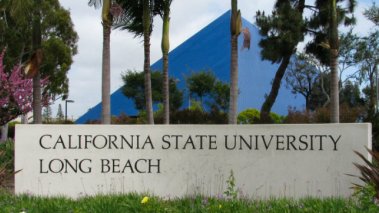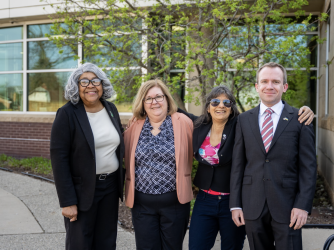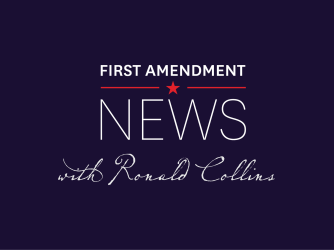Table of Contents
Cal State Long Beach’s response to anti-police brutality exhibit and firing of director raise questions about artistic freedom

At California State University, Long Beach, artist lauren woods’ exhibit on racism and police violence, “American Monument,” has been “paused” but “not pulled” at its opening. The artist announced a halt to the installation in response to the firing of University Art Museum executive director Kimberli Meyer. Additionally, woods reports that, in the months prior the opening of “American Monument,” administrators and even local police requested to review the contents of the project. FIRE is closely watching these developments.
Administrative and police review
“American Monument,” which woods worked on for nearly a year, presents 25 record players featuring audio from police reports, transcripts, and recordings of the deaths of African-Americans like Sandra Bland, Mike Brown, Alton Sterling, Philando Castile, Eric Garner, and more.
According to woods, administrators first expressed concerns about the content of the monument last December when she visited campus — including fears about whether it would attract the attention of white nationalists. “The first concern the upper management had was that it would attract tiki torch burners,” woods told Art News. After that, woods says, administrators sought to put limits on the work and asked to review its contents:
Woods said that once the administration learned that the work would be based around police brutality, they became concerned that it would invite backlash from alt-right groups. “In their fear of that, they started to micromanage and suffocate things,” woods told me. As an example, she cited their decision to limit the audio playback to inside the gallery instead of being broadcast on external speakers as well.
“They’ve had audio that had been in the plaza, but they censored this,” she said. “Out of their fear, the university is not supporting this. I thought, ‘can I work with a university that won’t stand up against police brutality?’”
According to woods, representatives from the Long Beach Police Department previewed the work recently and raised concerns about any video pertaining to a shooting in the local area in which officers might be able to be identified. She informed them that there was no video, only audio, in the work, and that seemed to allay their concern, she said.
A few weeks ago, woods said the administration asked for transcripts of all the audio on the records.
Meyer’s unexpected firing
Last Monday, less than a week prior to the show’s planned opening, woods supplied administrators with the transcripts they requested. The next day, September 11, Meyer was fired by Dean of the College of the Arts, Cyrus Parker-Jeannette, at what Meyer believed to simply be their scheduled monthly meeting. Meyer told the Los Angeles Times:
“They said they’d lost confidence in me and said they didn’t need to give me an explanation or tell me why,” Meyer says. “All I can say is that I’ve been fired and have been given no reason or cause, so I’ve filed an appeal. I’m shocked to have been so abruptly removed just days before the launch of ‘Monument,’ and I just don’t understand why.”
The university issued a statement on Monday. “While I cannot comment on personnel matters,” Parker-Jeannette wrote in the statement, “I can say this decision was part of a longer-term process. The ‘American Monument’ project continues at the museum as directed by the artist lauren woods. The installation is designed to provoke open and free discussion. Our campus is a place for civil discourse and artistic expression. ‘American Monument’ is part of this culture.”
Woods calls for a “pause” of the Monument
The university’s explanation did not reassure woods, who used the September 16 opening of “American Monument” to express her opposition to Meyer’s firing. Woods first read commentary Meyer intended to provide, had she not been fired, and later read her own statement, where she announced that the work was “paused” and “can only resume its co-creative process when restored, which can only happen with Kimberli Meyer retained as director of UAM.” Hyperallergic also reports that “several attendees interrupted opening remarks by Cyrus Parker-Jeannette, Dean of the College of the Arts, to ask why she did not include Meyer among the list of people she thanked.”
Though the Monument is open through December 9, woods has halted the audio portion and the public programming related to the work.
In a September 19 statement, university spokesperson Terri Carbaugh responded to some of woods’ concerns about her relationship with the university, asserting that administrators “sought transcripts not to curtail free speech or artistic expression, but to gain a clearer understanding if the campus would need to invest in counseling staff who could assist any student who might experience an emotional trigger as a result of the intensity of the exhibit.” Carbaugh further stated that there was no link between Meyer’s firing and the transcripts.
Meyer has already begun the appeal process.
“American Monument” joins other controversial campus artwork
If you’ve followed FIRE’s work, you might remember that this is not the first time Cal State Long Beach has pressured curators shortly before the planned opening of a controversial performance addressing race. In 2016, the university canceled the production of N*GGER WETB*CK CH*NK, a satirical play performed by Asian-American, Hispanic-American, and African-American actors who share their thoughts on race and identity while mocking stereotypes and racial slurs that perpetuate social injustice, over concerns about its content.
Incidentally, Parker-Jeannette, the administrator who fired Meyer, was also directly involved in the cancellation of N*W*C*. Months before the scheduled performance date, Parker-Jeanette called the then-executive director of the performing arts center, Michele Roberge, to inform her that “the President wants you to cancel the show.” Roberge resigned in protest, and the show’s performers were forced to find an off-campus venue. Cal State Long Beach earned a spot on FIRE’s “10 Worst” of 2017 list for its blatant act of censorship.
N*W*C*’s censorship, and the suppression of provocative works like it, is far from uncommon. This summer, FIRE released “One Man’s Vulgarity,” a report chronicling nearly 20 years of campus censorship of controversial artwork. In just the past few years alone, Salem State University temporarily closed an art exhibit because images of the Ku Klux Klan and Jews arrested during World War II caused “distress”; Winthrop University threatened to expel a student for an anti-lynching display that the university said was “contrary to [its] values”; and Florida’s Polk State College refused to display a professor’s anti-Trump artwork because it was “too controversial.”
And on July 11, 2018, just one day after the release of FIRE’s art censorship report, University of Kansas Chancellor Douglas Girod moved indoors an installation from nonprofit art organization Creative Time depicting a collage of the American flag with a dripped painting over it. Girod’s decision came hours after Kansas Governor Jeff Colyer and Kansas Secretary of State Kris Kobach demanded that the university remove the artwork.
A common theme threaded among the flag controversy at the University of Kansas and a number of stories discussed in “One Man’s Vulgarity” is that artwork focusing on racism in America elicits strong reactions — and administrative overreaction.
A need for administrative transparency
If woods is correct, similar concerns about “alt-right” backlash may have motivated Cal State Long Beach to examine her work in a way unbefitting of a university committed to free expression. Indeed, the university’s review of the transcripts played in the installation and the Long Beach Police Department’s questioning about whether police officers would be identifiable in the display raise troubling questions:
- Do Cal State Long Beach administrators and local police commonly review campus artwork before it is performed or displayed?
- If so, on what basis do they justify investigating artistic expression?
- If not, why was woods’ “American Monument” targeted for review?
- How did the Long Beach Police Department come to learn of the exhibit and request information on it?
- Which administrators reviewed the transcripts?
Cal State Long Beach’s administration would be well-served by offering a clear, public explanation of its review process of “American Monument.” Failure to do so would leave unanswered important questions about the university’s commitment to artistic freedom, and what students and faculty should expect if they choose to engage in controversial expression.
FIRE will watch the university’s next steps, as well as Meyer’s appeal, closely.
Recent Articles
FIRE’s award-winning Newsdesk covers the free speech news you need to stay informed.

VICTORY: Michigan town declares Sept. 6 ‘First Amendment Day’ after FIRE sues its mayor for shouting down residents

USC canceling valedictorian’s commencement speech looks like calculated censorship

Back into the FIRE: Hasen’s response to FIRE and Rohde: Don’t read the press clause out of the Constitution — First Amendment News 420
